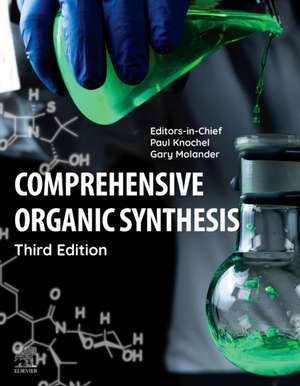Comprehensive Organic Synthesis
Paul Knochel, Gary A Molanderen Limba Engleză Hardback – aug 2025
This fully revised and updated edition provides an authoritative overview of core concepts, serving as a valuable resource for synthetic chemists requiring essential facts in new areas and students completely new to the field. The work remains an invaluable source for anyone seeking information on solving synthetic problems, ensuring it continues to be an essential reference work for all in the field of organic chemistry.
- Provides a completely revised and expanded new edition of the renowned Comprehensive Organic Synthesis series
- Contains around 200 advanced chapters, each written by distinguished chemists from across the globe who offer in-depth and detailed analysis of core topics such as bonds, oxidation, and reduction
- Includes more than 10,000 schemes and images
- Follows a consistent structure and features elements such as key objective boxes, summaries, figures, references, cross-references, etc.
Preț: 34517.01 lei
Preț vechi: 37930.78 lei
-9% Nou
Puncte Express: 51776
Preț estimativ în valută:
6605.05€ • 7062.85$ • 5506.98£
6605.05€ • 7062.85$ • 5506.98£
Carte nepublicată încă
Doresc să fiu notificat când acest titlu va fi disponibil:
Se trimite...
Preluare comenzi: 021 569.72.76
Specificații
ISBN-13: 9780323960250
ISBN-10: 0323960251
Pagini: 9500
Dimensiuni: 216 x 276 mm
Ediția:3
Editura: ELSEVIER SCIENCE
ISBN-10: 0323960251
Pagini: 9500
Dimensiuni: 216 x 276 mm
Ediția:3
Editura: ELSEVIER SCIENCE
Cuprins
1. Additions to C–X π-Bonds: comprehensive coverage of reactions involving carbon-bond formation with various substituents
2. Carbon–Carbon Bond Formation: fundamental methods for forming carbon-carbon bonds, essential for synthetic organic chemistry
3. Heteroatom Manipulation: techniques for introducing and modifying heteroatoms in organic molecules
4. Oxidation: various methodologies for oxidizing organic compounds, a cornerstone of synthetic transformations
5. Reduction: detailed approaches for reducing functional groups, providing essential strategies for chemists
6. Asymmetric Synthesis: methods for producing enantiomerically enriched compounds, increasingly important in pharmaceuticals
7. Photocatalysis: utilization of light to drive chemical reactions, highlighting innovative and sustainable synthetic strategies
8. Electrochemistry: emerging techniques for organic synthesis using electrochemical methods, signifying advancements in green chemistry
New Areas of Coverage in the 3rd Edition:
1. C-H Activation: new strategies for activating C-H bonds, enabling direct functionalization of hydrocarbons
2. Flow Chemistry: Innovative techniques for continuous flow synthesis, enhancing efficiency and scalability in organic synthesis
3. Dual Catalysis: recent developments in using two catalysts simultaneously for complex transformations
4. Biosynthesis: exploration of natural product synthesis through biological pathways, bridging organic chemistry and biochemistry
5. Catalytic Oxidation: Advanced methodologies for oxidation processes using modern catalytic systems
6. Photocatalysis: expanded focus on light-driven reactions, reflecting growing interest in sustainable and energy-efficient methods
7. Metal Catalysis: new approaches involving transition metals in catalysis, emphasizing their role in modern synthetic strategies
8. Asymmetric Synthesis: enhanced coverage of methods to achieve enantioselectivity in synthetic routes
2. Carbon–Carbon Bond Formation: fundamental methods for forming carbon-carbon bonds, essential for synthetic organic chemistry
3. Heteroatom Manipulation: techniques for introducing and modifying heteroatoms in organic molecules
4. Oxidation: various methodologies for oxidizing organic compounds, a cornerstone of synthetic transformations
5. Reduction: detailed approaches for reducing functional groups, providing essential strategies for chemists
6. Asymmetric Synthesis: methods for producing enantiomerically enriched compounds, increasingly important in pharmaceuticals
7. Photocatalysis: utilization of light to drive chemical reactions, highlighting innovative and sustainable synthetic strategies
8. Electrochemistry: emerging techniques for organic synthesis using electrochemical methods, signifying advancements in green chemistry
New Areas of Coverage in the 3rd Edition:
1. C-H Activation: new strategies for activating C-H bonds, enabling direct functionalization of hydrocarbons
2. Flow Chemistry: Innovative techniques for continuous flow synthesis, enhancing efficiency and scalability in organic synthesis
3. Dual Catalysis: recent developments in using two catalysts simultaneously for complex transformations
4. Biosynthesis: exploration of natural product synthesis through biological pathways, bridging organic chemistry and biochemistry
5. Catalytic Oxidation: Advanced methodologies for oxidation processes using modern catalytic systems
6. Photocatalysis: expanded focus on light-driven reactions, reflecting growing interest in sustainable and energy-efficient methods
7. Metal Catalysis: new approaches involving transition metals in catalysis, emphasizing their role in modern synthetic strategies
8. Asymmetric Synthesis: enhanced coverage of methods to achieve enantioselectivity in synthetic routes
